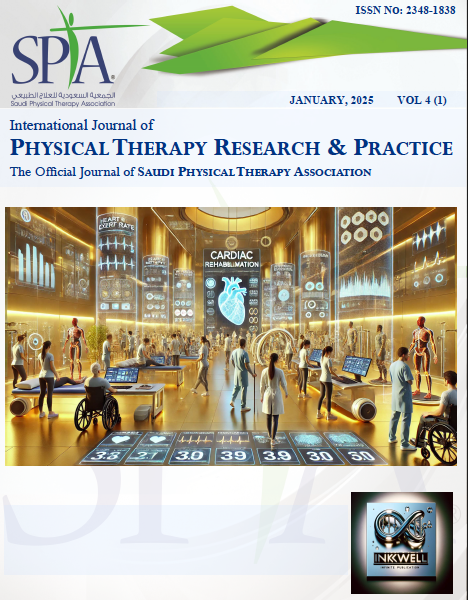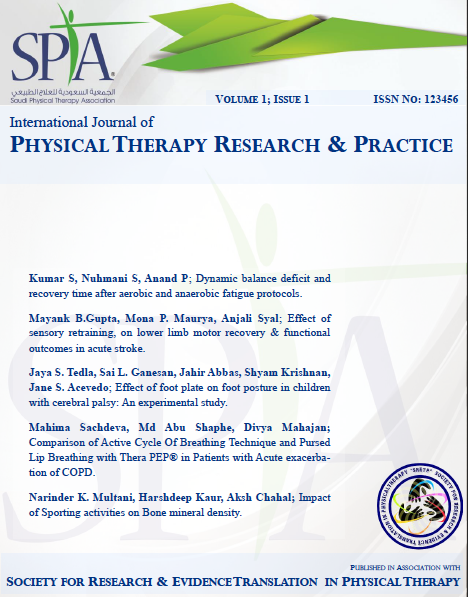Prevalence and risk factors of clubfoot in Al-Baha region - Saudi Arabia
DOI:
https://doi.org/10.62464/ijoprp.v4i1.80Keywords:
TEV, Clubfoot, Congenital deformity, Consanguinity, Congenital Talipes Equinovarus, Genetic Predisposition, Risk FactorAbstract
Background: Clubfoot, or Congenital talipes equinovarus (CTEV), is a structural defect that occurs early in pregnancy. It affects 1 in 1000 live births and can lead to permanent disability and severe social and economic consequences if untreated. It is more common in boys, with a male-to-female ratio of 2:1, and has a strong association with family inheritance and consanguinity. Objectives: To determine the prevalence of clubfoot and identify associated risk factors in the Al-Baha Region. Methods: The research team analyzed the medical records of patients from the orthopedic clinic at King Fahad Hospital between January 2020 and January 2024. A data sheet, designed by experts and consultants, captured demographic data, defect location, possible risk factors, associated anomalies, and treatment plans. Data analysis was conducted using Chi-square tests through SPSS v28. Results: The study found that 94.1% of patients were male, and 76.5% had bilateral deformities. Nearly half (47.1%) of the patients had parents with consanguineous marriages. Identified risk factors included preeclampsia, oligohydramnios, gestational diabetes, and family history of deformities. No significant correlation was found between maternal drug exposure or infections and clubfoot. Treatment, which primarily involved serial casting and Achilles tenotomy, resulted in 41.2% of patients walking normally post-treatment. Conclusions: This study highlights the prevalence of clubfoot in the Al-Baha region and its association with risk factors, emphasizing the importance of genetic screening, early diagnosis, and public awareness to improve outcomes.
References
Alasbali, M. S., Altammami, A. F., Alharbi, A. A., Aljurfi, M. M., Alhumaidan, A. I., AlKhudhair, M. R., Almuslmani, W. B., & Alkhalife, Y. I. (2023). Assessing awareness and knowledge level of clubfoot among a rural city population in Saudi Arabia: A cross-sectional study. Journal of Family Medicine and Primary Care, 12(1), 55–61. https://doi.org/10.4103/jfmpc.jfmpc_1097_22
Alomran, A. K., Alzahrani, B. A., Alanazi, B. S., Alharbi, M. A., Bojubara, L. M., & Alyaseen, E. M. (2024). Prevalence and associated factors of clubfoot in the eastern province of Saudi Arabia: A hospital-based study. World Journal of Orthopedics, 15(7), 635–641. https://doi.org/10.5312/wjo.v15.i7.635
Alosaimi, M. A., Jawhari, A. M., Amin, O. A., Alzahrani, E. S., Alomar, M. O., Nouri, M. T., Altalhi, M. J., & Marzogi, A. A. (2022). Community Awareness of Congenital Talipes Equinovarus (Clubfoot) in Makkah Region, Saudi Arabia: A Cross-Sectional Study. Cureus. https://doi.org/10.7759/cureus.30602
Ansar, A., Rahman, A. E., Romero, L., Haider, M. R., Rahman, M. M., Moinuddin, M., Siddique, M. A. B., Mamun, M. Al, Mazumder, T., Pirani, S. P., Mathias, R. G., Arifeen, S. E., & Hoque, D. M. E. (2018). Systematic review and meta-analysis of global birth prevalence of clubfoot: a study protocol. BMJ Open, 8(3), e019246. https://doi.org/10.1136/bmjopen-2017-019246
Bhatti, A., Yousuf Bhatti, M., & Faizan Ali, M. (n.d.). Association of Consangiunity, Ethincity and Addiction with Clubfoot in Pakistan.
Chen, C., Kaushal, N., Scher, D. M., Doyle, S. M., Blanco, J. S., & Dodwell, E. R. (2018). Clubfoot Etiology: A Meta-Analysis and Systematic Review of Observational and Randomized Trials. Journal of Pediatric Orthopaedics, 38(8), e462–e469. https://doi.org/10.1097/BPO.0000000000001191
Dreise, M., Elkins, C., Muhumuza, M. F., Musoke, H., & Smythe, T. (2023). Exploring Bracing Adherence in Ponseti Treatment of Clubfoot: A Comparative Study of Factors and Outcomes in Uganda. International Journal of Environmental Research and Public Health, 20(14), 6396. https://doi.org/10.3390/ijerph20146396
Fakeeha, J. H., Alessa, A. E., Alkhaldi, M. S., Alshathri, M. H., & Althunayyan, A. N. (2021). Prevalence and epidemiological description of clubfoot at King Saud Medical City, Riyadh, Saudi Arabia. Journal of Musculoskeletal Surgery and Research, 5(4), 246–249. https://doi.org/10.25259/JMSR_60_2021
Golshan-Tafti, M., Dastgheib, S. A., Alijanpour, K., Bahrami, R., Mazaheri, M., & Neamatzadeh, H. (2024). A thorough analysis of data on the correlation between COL9A1 polymorphisms and the susceptibility to congenital talipes equinovarus: a meta-analysis. Journal of Orthopaedic Surgery and Research, 19(1), 345. https://doi.org/10.1186/s13018-024-04834-5
Grimes, C. E., Holmer, H., Maraka, J., Ayana, B., Hansen, L., & Lavy, C. B. D. (2016). Cost-effectiveness of club-foot treatment in low-income and middle-income countries by the Ponseti method. BMJ Global Health, 1(1), e000023. https://doi.org/10.1136/bmjgh-2015-000023
Håberg, Ø., Foss, O. A., Lian, Ø. B., & Holen, K. J. (2020). Is foot deformity associated with developmental dysplasia of the hip? The Bone & Joint Journal, 102-B(11), 1582–1586. https://doi.org/10.1302/0301-620X.102B11.BJJ-2020-0290.R3
Hedley, P. L., Lausten-Thomsen, U., Conway, K. M., Hindsø, K., Romitti, P. A., & Christiansen, M. (2023). Trends in congenital clubfoot prevalence and co-occurring anomalies during 1994–2021 in Denmark: a nationwide register-based study. BMC Musculoskeletal Disorders, 24(1), 784. https://doi.org/10.1186/s12891-023-06889-7
Janatová, K., Nováková, T., & Lopot, F. (2023). The Incidence of Clubfoot in the Czech Republic: A Nationwide Epidemiological Study from 2000 to 2014. Children, 10(4), 714. https://doi.org/10.3390/children10040714
Kardm, S. M., Al Zomia, A. S., Alqahtani, A. A., Al Fae, F. M., Al Zehefa, I. A., Alshahrani, Y. S., A AlShehri, F. A., Alqarni, A. M., & Alqahtani, A. S. (2023). Congenital Talipes Equinovarus Management and Outcomes: The Experiences of Pediatric Tertiary Centers in Abha, Saudi Arabia. Cureus. https://doi.org/10.7759/cureus.43264
Mohsenh, W. A., Alqarni, M. M., Alshehri, A. K., Asiri, A. M., Mohsenh, O. H., Mahmood, S. E., Alhifzi, A. I., Mohsenh, R. H., & AL Zomia, A. S. (2023). Factors Related to Relapse of Congenital Talipes Equinovarus (CTEV) After the Ponseti Method. Cureus. https://doi.org/10.7759/cureus.43701
Moteb, S., Kardm1, S., Saad, H., Abojlaid2, A., Ahmed, A., Alasiri2, L. A., Lahiq2, L., Ghanim, A., Aldaraani2, W., & Ebrahim, A. (2022). What Does Aseer Region Community Know About Club Foot, Its Related Risk Factors, And Management Options? In Journal of University Studies for Inclusive Research (Vol. 10).
Mustari, N. M., Faruk, M., Bausat, A., & Fikry, A. (2022). Congenital talipes equinovarus: A literature review. Annals of Medicine & Surgery, 81. https://doi.org/10.1016/j.amsu.2022.104394
Parker, S. E., Mai, C. T., Strickland, M. J., Olney, R. S., Rickard, R., Marengo, L., Wang, Y., Hashmi, S. S., & Meyer, R. E. (2009). Multistate study of the epidemiology of clubfoot. Birth Defects Research Part A: Clinical and Molecular Teratology, 85(11), 897–904. https://doi.org/10.1002/bdra.20625
Sahin, O., Yildirim, C., Akgun, R. C., Haberal, B., Yazici, A. C., & Tuncay, I. C. (2013). Consanguineous Marriage and Increased Risk of Idiopathic Congenital Talipes Equinovarus. Journal of Pediatric Orthopaedics, 33(3), 333–338. https://doi.org/10.1097/BPO.0b013e3182784af4
Saini, R., Sharma, A., Ravalji, D., Baisoya, K., & Sharma, G. (2023). A Prospective Study on Functional Outcomes of Serial Cast Correction in Congenital Talipes Equinovarus (CTEV) by Ponseti Method. Cureus. https://doi.org/10.7759/cureus.35987
Salvatori, G., Bettuzzi, C., Abati, C. N., Cucca, G., Zanardi, A., & Lampasi, M. (2020). The influence of laterality, sex and family history on clubfoot severity. Journal of Children’s Orthopaedics, 14(2), 145–150. https://doi.org/10.1302/1863-2548.14.190184
Smythe, T., Kuper, H., Macleod, D., Foster, A., & Lavy, C. (2017). Birth prevalence of congenital talipes equinovarus in low- and middle-income countries: a systematic review and meta-analysis. Tropical Medicine & International Health : TM & IH, 22(3), 269–285. https://doi.org/10.1111/tmi.12833
Ugorji, T. N. (2020). Epidemiology and Pattern of Clubfoot in Enugu, South- East Nigeria. American Journal of Biomedical Science & Research, 11(2), 190–193. https://doi.org/10.34297/AJBSR.2020.11.001619
Van Schelven, H., Moerman, S., Van Der Steen, M., Besselaar, A. T., & Greve, C. (2021). Prognostic factors for recurrent idiopathic clubfoot deformity: a systematic literature review and meta-analysis. Acta Orthopaedica, 1–9. https://doi.org/10.1080/17453674.2021.1982576
Vukasinović, Z. S., Slavković, N. S., Zivković, Z. M., & Bascarević, V. D. (2010). [Congenital club foot]. Acta Chirurgica Iugoslavica, 57(1), 73–76. https://doi.org/10.2298/aci1001073v
Wang, N., Zhang, J., Lv, H., & Liu, Z. (2022). Regulation of COL1A2, AKT3 genes, and related signaling pathway in the pathology of congenital talipes equinovarus. Frontiers in Pediatrics, 10. https://doi.org/10.3389/fped.2022.890109

Downloads
Published
Issue
Section
License
Copyright (c) 2025 International Journal of Physical Therapy Research & Practice

This work is licensed under a Creative Commons Attribution-NonCommercial-NoDerivatives 4.0 International License.



